Roses, Dowitchers, Terns and Seals
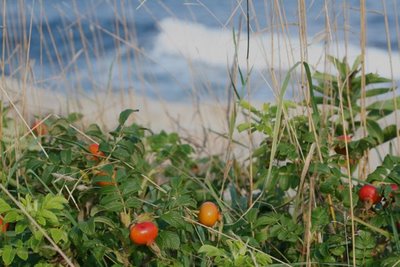 Rosa rugosa, an Asian import, bears its cheerful orange hips against the sea spray. There aren't many exotics that seem to belong, but this lovely plant, with its giant single pink or white flowers, its pure attar-of-rose scent, and its edible hips, feels right to me.
Rosa rugosa, an Asian import, bears its cheerful orange hips against the sea spray. There aren't many exotics that seem to belong, but this lovely plant, with its giant single pink or white flowers, its pure attar-of-rose scent, and its edible hips, feels right to me.It is good, especially in fall, when melancholy seems always to wait in the wings, to go someplace, someplace utterly different than home, as beautiful as home is. It satisfies some ancient urge in us to be moving, changing scenes, I think. I am gratefuul to Swarovski North America for taking me out to Cape Cod and letting me remember that somewhere, there are shorebirds flocking and waves pounding distant shores.
The herring gull told the season in the worn banners of its primary feathers. Melanin, the black pigment, strengthens wingtips against wear, but the decorative white spots, which birders call mirrors, melt completely away with the friction of the constantly beating air. This is why even pure white birds like ibises and snow geese accessorize with black wingtips. Black-billed magpies have a fringe of black around their white flight feathers. It's all about preventing excess wear.
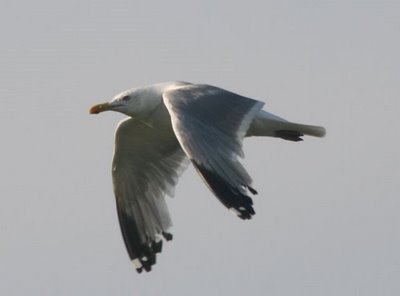
They were massing, these birds, for the flight south; had already completed quite a leg of it. Hudsonian godwits nest where the midnight sun never sets--way up on Hudson's Bay.
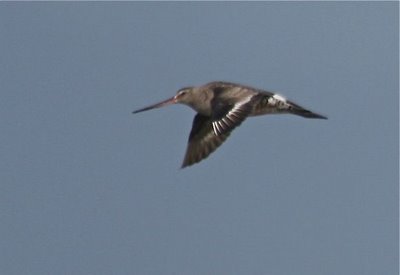
A sanderling clung to its breeding plumage, but it was fading fast. Soon it would be winter-white, the whitest sandpiper around.
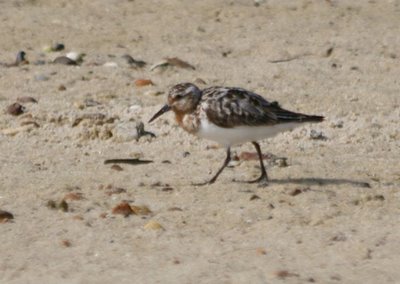
By some miracle, I was able to focus on these short-billed dowitchers without aid of my (disabled) image stabilizer. Hey, sometimes lightning strikes. Look at the uppermost bird-- how the white rump stripe runs all the way up their backs. The pale inner wing feathers--the secondaries--are distinctive, too. But the only easy way to tell them from long-billed dowitchers is by their toodleoodleoodle call. (long-billeds have a single note).
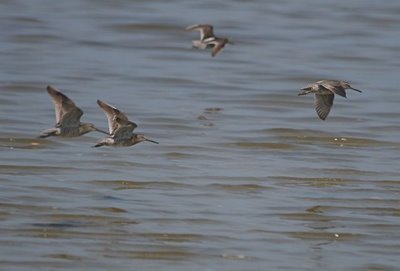
A roseate tern shone like quicksilver in the mass of darker common terns. His nasal zaaap! call rang out over his companions' keening complaints.
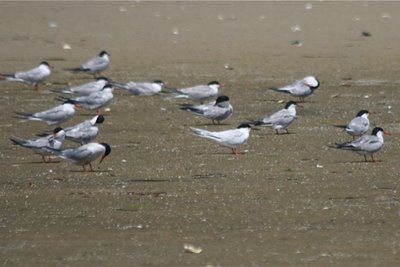 Roseate terns are endangered; a frighteningly large percentage of the population nests on Bird Island off Cape Cod; other outliers are scattered throughout the Northeastern coastal islands. They depend for their survival on wise gull management; where there are nesting gulls, there will be no roseate terns nesting. Roseate terns, like Atlantic puffins, are completely dependent on people to fight back the gulls we encourage with lobster bait, landfills, and pizza. Relax our vigilance, allow the gulls to nest on tern islands, and the tern eggs and young simply vanish down gull throats.
Roseate terns are endangered; a frighteningly large percentage of the population nests on Bird Island off Cape Cod; other outliers are scattered throughout the Northeastern coastal islands. They depend for their survival on wise gull management; where there are nesting gulls, there will be no roseate terns nesting. Roseate terns, like Atlantic puffins, are completely dependent on people to fight back the gulls we encourage with lobster bait, landfills, and pizza. Relax our vigilance, allow the gulls to nest on tern islands, and the tern eggs and young simply vanish down gull throats.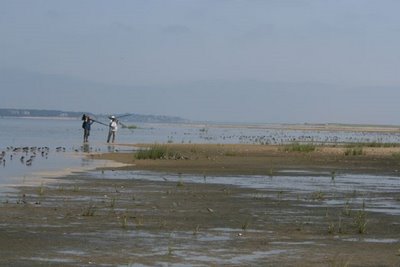
Oh, it was good to be surrounded by shorebirds.
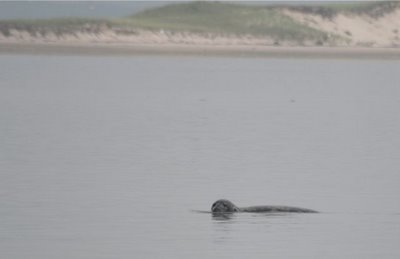
And how couuld I forget the young male gray seal who was slooshing around our landing site in a desultory way? Gray seals are a recent phenomenon on Cape Cod, having moved well south of their traditional pupping areas to breed on offshore islets in Massachusetts. Sometimes called "horseheads," they're huge, and more imposing than the little round-headed harbor seals. What a cool sight, one I'd only seen in Newfoundland or on Maine's Monhegan Island prior to this.
Looking up
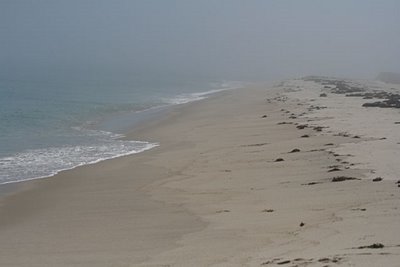
and down the misty beach soothed my soul.
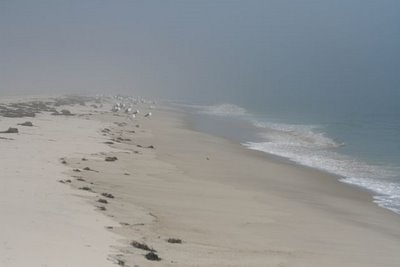
There's another post beneath this'n; don't miss it! Yesss, sometimes the Ant posts twice.
Labels: gray seals, Hudsonian godwits, rosa rugosa, short-billed dowitchers





